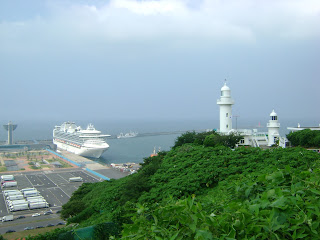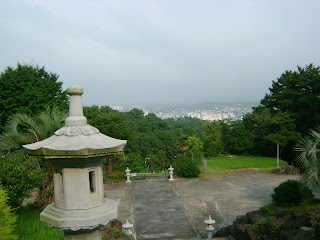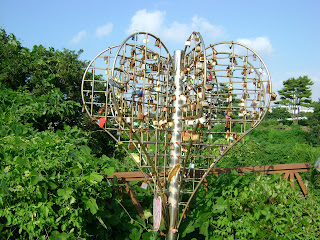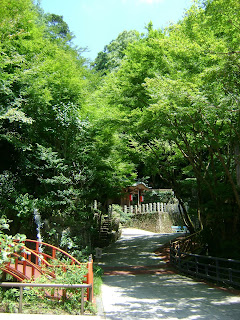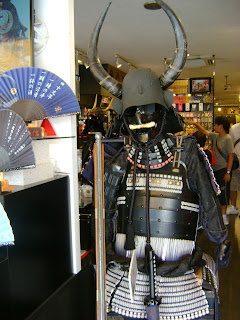Day 1: Nara
On our first day post-cruise, we walked about 10 minutes from Osanbashi Pier in Yokohama to Yokohama Station. We caught the train to Shin-Yokohama Station where we were able to transfer to a shinkansen (bullet-train) to get to Kyoto. It was, without a doubt, the smoothest and most comfortable train ride I had ever taken.
The hotel was a mere 5 minute walk from Kyoto Station which made it a really convenient location to stay at for day-trips to Osaka, Nara and beyond! Upon dropping off our luggage at the hotel, we walked back to Kyoto Station to take a train to Nara.
After exiting Nara Station we headed towards Sanjo Dori which is a really popular street for it's variety of restaurants and souvenir shops lining both sides of the road. There were also many side streets jutting from Sanjo Dori which we didn't have time to explore but looked interesting nevertheless.
Within 20 minutes of walking from Nara Station we reached Kofukuji Temple where we saw wild deers all around. Walking a bit further, towards Todaiji Temple, and passing by Nara Park we continued seeing many deers milling about. Near Todaiji Temple it was fun to watch people feeding senbei (crackers) they bought from the vendors nearby to feed to the deers. Many of the deers have gotten used to humans and can get quite aggressive when they see you holding senbei in your hand.
Day 2: Arashiyama; Kyoto
The highlight of my 5 day post-cruise trip was on the second day.
We started the day by taking the train from Kyoto Station to Arashiyama Station. We made our way to the Bamboo Grove and walked through the beautiful trail surrounded by massively high bamboo trees.
 |
| The beautiful Bamboo Grove |
The 550 yen entrance fee for the Monkey Park was worth every cent (or more appropriately, yen) for the price of admission. There was a bit of a hike to actually reach the park from the entrance (about 20 minutes of walking on an uphill trail) but it was a nice hike where you could both see and hear the gushing water from the river down below. At the top of the hill is the actual Monkey Park where the macaques (Japanese "snow" monkeys) wander around freely.
 |
| The adorable baby monkey |
 |
| Monkeys roaming around freely |
 |
| Humans inside the "cage" to feed the monkeys in the open park |
 |
| Crowds plus rushing to get a photo of the Torii Gates equals blurry photo |
Day 3: Kyoto
We had planned out our day to be a bus only day to take advantage of the Kyoto City Bus One-Day Pass for 500 yen. We bought the pass at JR Kyoto Station Central Entrance Bus Information Center. We took bus 205 to Kinkaku-ji Temple (Golden Pavilion; entrance fee: 400 yen) from Kyoto Station. It was easy to figure out when to get off the bus (at Kinkakuji-michi bus stop) because the buses have announcements and messages on the TV in both English and Japanese mentioning which bus stop was next. After spending some time soaking in the beauty of the Golden Temple we took a bus back to Kyoto Station.
 |
| The majestic looking Golden Pavilion |
 |
| A closer look at the Golden Pavilion |
After winding around the different alleys around Nishiki Market, and stopping to buy food to eat while we walked, we headed to Shijo Dori. As soon as you pass the Kamo River, Shijo Dori becomes Shijo Avenue.
 |
| Walking by the Kamo River in the evening |
Day 4: Osaka
We took a train from Kyoto Station to Ikeda Station in Osaka. We walked 5 minutes from the station to The Momofuku Ando Instant Ramen Museum (free admission). Inside the museum they had packaging from all the cup/bowl/instant noodles ever produced by the Nissin brand.
 |
| So many interesting flavours of cup/bowl noodles! |
When we finished eating our noodles we walked about 25 minutes to the Satsukiyama Zoo (free admission). We saw Australian animals like wombats and wallabies, as well as alpacas found in the Andes. After a brief time spent walking around the small zoo, we walked back to Ikeda Station and took a train to Tenjimbashisujirokuchome Station. We left through exit 8 to get to the Tenjimbashisujirokuchome Shopping Arcade and walked through the undercover shopping arcade from 6-chome to 2-chome.
 |
| A view of 3-chome from the street |
Day 5: Osaka
On our fifth and final day post-cruise, we went back to Osaka. From Kyoto Station we took a train to Osakajokoen Station to get to Osaka Castle. As we exited the station we headed towards Osaka-Jo Hall and saw a lot of signs directing the way to Osaka Castle (about 20 minutes walk).
 |
| Approaching Osaka Castle |
Not far from Osaka Castle Park is the Osaka NHK Broadcasting Center. We went up to the 9th floor to see the TV studio set and observe them filming a show.
A 5 minute walk from the Broadcasting Center is Tanimachi-4-chome Station where we took a train to Namba Station. We found our way to exit 14 and made a left as we left exit 14, and another left again at the "intersection" to head in the direction of Dontonbori (as confusing as that may sound it was only a 5 minute walk). Dontonbori is famous for it's street food and it's huge neon and moving plastic signs.
 |
| Giant crab sign in Dontonbori |
 |
| Dontonbori is full of giant plastic signs |
 |
| This is where we bought gyoza to eat |
When we were full from eating in Dontonbori we took the subway to Umeda Station. We wanted to see a view of Osaka atop the Umeda Sky Building. We got out at exit 5 and headed towards Grand Front Osaka to find the underground passageway. As we exited the passageway the Umeda Sky Building was right across the street (it took about 10 minutes to walk there from Umeda Station). Once inside the building we went up to the 3rd floor by escalator at which point we had to take the elevator 140 meters up to the 35th floor. Then we took the escalators to the 38th floor where there was a shop and also floor-to-ceiling windows to look down onto Osaka below. You can pay 1000 yen to go the the 39th floor Observation Garden but we chose to forego that option.
 |
| View of Osaka from the 38th floor of Umeda Sky Building |
 |
| A quintessential dining experience to try in Japan |







